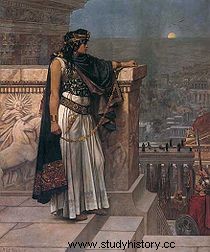Twelfth installment of “Archienemies of Rome “. Collaboration of Gabriel Castelló.

Our archenemy of today is a little-known woman, but a true heroine of ancient times, the legendary queen Zenobia of Palmyra , an educated woman with a strong temperament and vision of the state who was able to fill the power vacuum in the Middle East during the turbulent second half of the 3rd century. It is not possible to talk about Zenobia without talking about her beloved homeland, Palmyra (today near Tadmor, Syria), at that time one of the richest and most splendid cities of the Roman East. “The city of date trees”, translated from Aramaic, was located in the Afqa Oasis and was an obligatory stop for the caravan routes that linked Persia with the cities of the Hellenistic East. This privileged position made the Nabataean tribes that inhabited it prosper with trade, serving as a hinge between the two great powers of the time. It came to have 200,000 inhabitants, a spectacular figure for those times (in 260 Emérita Augusta did not have more than 20,000 souls and Valentia or Saguntum did not exceed 8,000)
Septimia Bathzabbai Zainib, known today as Zenobia Due to the Latinization of her name, she was born in Palmyra on December 23, 245. Daughter of an influential citizen, Zabaii Ben Selim ( Julius Aurelius Zenobius in Roman chronicles), she was betrothed to a local vassal prince of the Empire and a Roman citizen since Severan times, Odainath, son of Hairán of Tadmor (better known as Septimius Odaenus ) We do not know with certainty on what date Odaenathus ascended to the regency of Palmyra, but it is known from an inscription that in 258 he already exercised control of the city.
They enjoyed a quiet regency until the great crisis that broke out in 260. Emperor Valerian he was captured by the Persian king Shapur I in Edessa (Syria) and later taken as a prisoner to Persepolis. Some sources say that there they made him drink molten gold, skinned him and made a trophy with his skin. Apart from such an ignominious death, what was truly important was the political and military vacuum in which the entire Roman East was plunged after the tragedy of Edessa. The shadow of a possible betrayal by Macrino , the praetorian prefect, added to the lack of a clear direction in the operations, led the Sassanian Persians to plunder much of Syria, Cilicia and Cappadocia.
Odaenathus, unhappy with the rise of his neighbor Shapor and the new Persian hegemony in his area of influence, tried to bribe him, but the Persian king returned his gifts. That contempt provoked Odenato's anger, forcing him to take part in a conflict from which he could no longer escape. Since Hadrian's time, Palmyra was a free city, but an open war between the Persians and the Romans was the worst for trade, the only source of income for his city-state. By surprise, he decided to attack the Persian troops returning from the sack of Antioch on the banks of the Euphrates, opening hostilities with Persia.
Not only did Odaenathus have to choose a side, but also a pretender to the imperial throne. The chosen one was Galieno , son of the late emperor. In a highly precise tactical action, he attacked and killed the other purple aspirant, thereby gaining a highly advantageous position and earning the honorary title of Totius Orientis Imperator. From 262 to 266 he dedicated himself to recovering the territories lost to the Persian offensive, including some beyond such as Edessa, Carras and Nineveh. His successful campaigns re-established Roman rule in the East, though it was obvious that Odaenathus was supplanting Roman authority by his own personal project. Perhaps because of this, or out of simple envy, when he was about to launch an offensive against the Goths he was killed along with his eldest son, Hairán (Herod) by his nephew Maconius. It has not been possible to prove that the dark hand of Rome was behind that assassination, although it was entirely appropriate for the weak imperial administration.

The death of her husband and her eldest son left Queen Zenobia heartbroken and furious. Her son Vabalato he was still a minor, so the city council granted him the regency of Palmyra until he could take over from his late father. Perhaps due to the suspicion that Rome had orchestrated that murder, or to see her husband's great dream come true, Zenobia declared herself in rebellion. The queen herself saw the opportunity to fill the Sassanid power vacuum by taking advantage of the Roman instability and form a new state that would mediate between the two powers. She for a while she got it. She went on to occupy large territories in Asia Minor and depose a new Roman claimant in Egypt, incorporating him into her new territories. Zenobia was a polyglot, cultured and refined woman, trained in rhetoric, in whose court men of science and proven wisdom resided, such as Paul of Samosata , a theologian whose doctrine would be applied by her disciple Arius , the creator of Arianism, a Christian current that caused many problems. We cannot say if she became a Christian, it is more likely that she was closer to Zoroastrianism.
That political and religious sedition became annoying and dangerous for Rome. A succession of feeble emperors allowed Zenobia to expand and consolidate her power, a dream of independence cut short when Lucius Domitius Aurelianus , new emperor since 270, a fierce and hardened man from the legions, entered the scene. In 272, having successfully averted an invasion of Alamanni tribes in Italy and defeated the Goths in Dacia, he set his sights on the eastern problem. The "Empire of Palmyra" recognized Aurelian as emperor, although it reserved the title of rex for Vabalato. That formalism that was completely irrelevant in practice was not convincing for the emperor, so when Aurelian felt strong he launched an offensive against the territories controlled by Zenobia.
It was a quick campaign. After several assaults and destructions by the legions, the rest of the cities of Asia Minor gave up their sedition, as well as Egypt and Syria. Three battles took place, Inmae and Emesa, in Syria, the last one ending with the siege of Palmyra. Zenobia tried to flee with her children from the city and take refuge in Persia, but the Roman troops captured her and handed her over to the emperor. Upon learning of her capture, the city ceased its belligerence and peace was signed.
The queen was taken to Rome and paraded in gold chains at the triumph the emperor celebrated on her arrival. Legend has it that Aureliano was so captivated by the size and beauty of the deposed queen that he granted her a worthy exile, freeing her and assigning her a luxurious villa in Tibur (Tivoli, Italy). It is possible that she ended her days there, as the wife of some senator .
Her forced retirement saved him from seeing Palmyra sacked and destroyed by Roman troops only a year after his surrender. Since the queen's capture there had been several minor clashes in the area that Aureliano put down forcefully. The sad end of Palmyra was caused by a chain of battles against the Persians in Egypt and Syria that led to their assault and destruction.
Palmyra It is today a first class tourist center in Syria, the Pompeii of the desert. To read a good novel set in these turbulent times, I recommend the magnificent “Puertas de Seda ”, by Olalla García .

